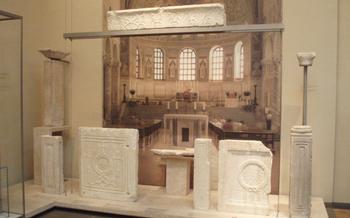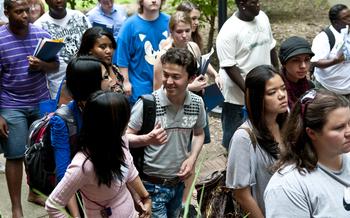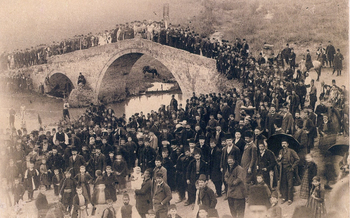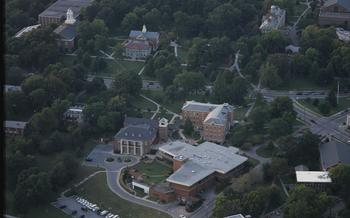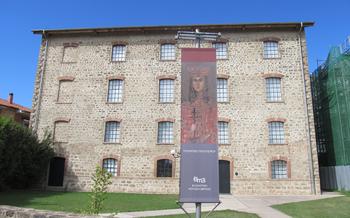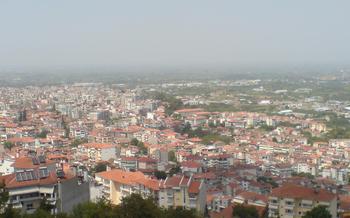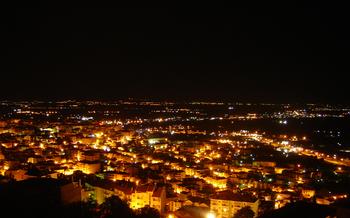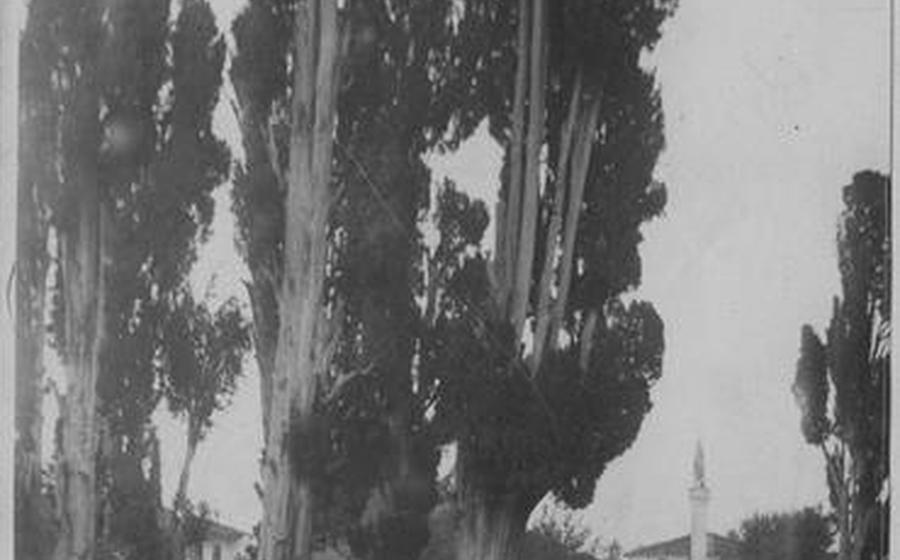
Museum of Byzantine Education
- Location of the Museum
- Architectural Elegance
- Byzantine Art Collection: A Journey Through History
- Manuscripts and Codices
- Educational Programs
- Temporary Exhibitions
- Historical Context
- Religious Significance:
- Cultural Workshops: Embracing Byzantine Traditions
- Research Opportunities: A Haven for Scholars
- Accessibility and Facilities
- Guided Tours: Enriching Your Museum Experience
- Insider Tip: To fully appreciate the museum's exhibits and avoid crowds, plan your visit for a weekday morning. Also, keep an eye out for special events or temporary exhibitions that may be taking place during your stay in Veria. These events often offer unique insights into Byzantine culture and history, making your visit even more memorable.
Location of the Museum
The Museum of Byzantine Education is conveniently situated in the heart of Veria, a city steeped in Byzantine history. It can be found at 28 Oktovriou Street, within easy walking distance of several prominent landmarks. The museum's central location makes it an accessible and convenient destination for visitors exploring the city's Byzantine heritage.
Those arriving by car can utilize the ample parking spaces available in the vicinity of the museum. Alternatively, visitors can opt for public transportation, as the museum is well-connected by bus routes. The surrounding area offers a plethora of attractions, including the historic Panagia Gorgoepikoos Church, the Archaeological Museum of Veria, and the picturesque Old Town, inviting visitors to delve deeper into Veria's rich cultural tapestry.
Architectural Elegance
The Museum of Byzantine Education proudly stands as a testament to architectural brilliance, harmoniously blending modern design with traditional elements. Its striking exterior, a fusion of stone and glass, captivates visitors with its contemporary elegance. As you step inside, the museum's interior unveils a world of sophistication and functionality. High ceilings and an abundance of natural light create a spacious and inviting atmosphere, allowing the exhibits to take center stage.
The museum's design cleverly integrates elements of Byzantine architecture, paying homage to the city's rich heritage. Ornate arches and intricate mosaics adorn the walls, adding a touch of grandeur to the space. Careful attention to detail is evident throughout, from the custom-designed display cases to the subtle lighting that enhances the artifacts' beauty.
A highlight of the museum's architectural design is its impressive central atrium, which serves as a gathering space and a hub for educational activities. The atrium's soaring height and glass ceiling create a sense of awe and wonder, drawing visitors' eyes upwards to admire the intricate details of the Byzantine-inspired ceiling murals.
The Museum of Byzantine Education is not merely a repository of artifacts; it is a work of art in its own right, seamlessly blending form and function to create a truly immersive and enriching experience for visitors.
Byzantine Art Collection: A Journey Through History
The Museum of Byzantine Education in Veria houses a remarkable collection of Byzantine art that transports visitors back in time to a period of profound religious and cultural expression. Among the most notable artifacts are stunning mosaics, meticulously crafted icons, and intricate frescoes that adorn the museum's walls and display cases. These artworks showcase the exceptional skill and artistry of Byzantine craftsmen, capturing the essence of an era deeply rooted in Christian faith and imperial grandeur.
One of the highlights of the collection is a series of well-preserved mosaics that depict scenes from the Bible and the lives of saints. The vibrant colors and intricate details of these mosaics offer a glimpse into the visual language of the Byzantine period, where religious narratives were brought to life through art. Visitors can marvel at the mosaic depicting the Transfiguration of Christ, a powerful representation of the divine nature of Jesus.
Equally captivating are the museum's collection of icons, which showcase the deep devotion and artistry of Byzantine iconographers. These sacred images, painted on wood or metal, feature serene and expressive faces of saints and religious figures. The icon of the Virgin Mary holding the infant Jesus, known as the Theotokos with Child, is particularly striking, exuding a sense of tenderness and reverence.
The frescoes that adorn the museum's walls and ceilings further enhance the immersive experience, providing a glimpse into the decorative arts of the Byzantine era. These vibrant and intricate paintings depict scenes from history, mythology, and religion, offering a visual narrative that transports visitors to a bygone era.
The Byzantine art collection at the Museum of Byzantine Education is a testament to the enduring legacy of the Byzantine Empire, showcasing the artistic and spiritual achievements of a civilization that left an indelible mark on the history and culture of the region.
Manuscripts and Codices
The collection of Byzantine manuscripts and codices at the Museum of Byzantine Education in Veria holds immense historical and cultural value, as these manuscripts provide an invaluable glimpse into the Byzantine Empire's written heritage.
The museum houses a significant number of manuscripts dating from the 9th to the 16th centuries, written in both Greek and Latin. These manuscripts encompass various subjects, including theology, philosophy, history, literature, and science, offering insights into the intellectual pursuits and scholarly endeavors of the Byzantine era.
Among the notable manuscripts in the collection is the "Veria Codex," dating from the 10th century. This codex contains the complete text of the four Gospels in Greek, along with other religious texts and commentaries. It is considered a significant example of Byzantine manuscript illumination, featuring intricate decorative elements and colorful illustrations.
Another highlight of the collection is the "Homilies of Gregory of Nazianzus," a 10th-century manuscript featuring the homilies of the prominent Cappadocian Father, Gregory of Nazianzus. This manuscript is adorned with exquisite miniatures and headpieces, demonstrating the artistic skill and craftsmanship of Byzantine scribes and illuminators.
The Museum of Byzantine Education has also digitized a selection of its manuscripts, making them accessible to researchers and the general public online. This digitalization effort ensures the preservation and wider dissemination of these valuable historical documents, enabling scholars to conduct research and enthusiasts to explore the rich literary and cultural heritage of the Byzantine Empire.
Educational Programs
The Museum of Byzantine Education offers a range of educational programs designed to engage visitors of all ages and backgrounds. These programs aim to promote a deeper understanding of Byzantine history, art, and culture.
Workshops:
The museum regularly hosts workshops that provide hands-on experiences related to Byzantine art and culture. Visitors can participate in workshops on topics such as Byzantine manuscript illumination, icon painting, and traditional Byzantine crafts. These workshops offer a unique opportunity to learn from experts and create their own Byzantine-inspired artworks.
Lectures:
The museum organizes lectures and talks by renowned scholars and experts in Byzantine studies. These lectures cover various aspects of Byzantine history, art, and culture, providing visitors with in-depth knowledge and insights into the Byzantine world.
Guided Tours:
The museum offers guided tours that provide visitors with a comprehensive overview of its exhibits and collections. Experienced guides lead these tours, sharing their knowledge and insights about Byzantine history and culture. Visitors can choose from various tour options, including general tours, thematic tours, and family-friendly tours.
Temporary Exhibitions
The Museum of Byzantine Education keeps its visitors engaged and informed through its dynamic program of temporary exhibitions. These exhibitions delve into various aspects of Byzantine art, history, and culture, offering a fresh perspective to complement the museum's permanent collection. Past exhibitions have showcased stunning Byzantine jewelry, explored the evolution of Byzantine religious iconography, and shed light on the daily lives of Byzantine citizens. Upcoming exhibitions promise to continue this tradition of excellence, providing visitors with unique insights into the Byzantine world.
Historical Context
The Byzantine Empire, a continuation of the Roman Empire, spanned over a thousand years, from the 4th to the 15th century. During this time, Veria played a significant role as a thriving cultural and religious center within the empire. Its strategic location on the Via Egnatia, a major trade and communication route, contributed to its importance. Veria was home to numerous churches, monasteries, and other Byzantine monuments, reflecting its deep connection to the Byzantine era. Understanding this historical context is crucial for appreciating the significance of the Museum of Byzantine Education and the city's rich Byzantine heritage.
Religious Significance:
The Byzantine period was a time of great religious fervor and devotion, and Veria was no exception. The city was home to a number of important churches and monasteries, which served as centers of worship and learning. Many of these churches still stand today, and they are a testament to the deep religious beliefs of the Byzantine people.
One of the most important churches in Veria is the Panagia Gorgoepikoos Church, which dates back to the 11th century. The church is dedicated to the Virgin Mary, and it is said to have been built on the site of a pagan temple. The church is home to a number of beautiful Byzantine frescoes, which depict scenes from the Bible and the lives of the saints.
Another important church in Veria is the St. Nicholas Church, which was built in the 12th century. The church is dedicated to St. Nicholas, the patron saint of sailors, and it is located near the city's harbor. The church is home to a number of beautiful Byzantine mosaics, which depict scenes from the life of St. Nicholas.
The Veria Byzantine Museum also houses a number of religious artifacts, including icons, manuscripts, and vestments. These artifacts provide a glimpse into the religious life of the Byzantine people, and they are a valuable resource for scholars and researchers.
Cultural Workshops: Embracing Byzantine Traditions
The Museum of Byzantine Education in Veria offers a unique opportunity to delve deeper into the rich cultural heritage of the Byzantine era through its engaging cultural workshops. These hands-on experiences allow visitors to learn about and participate in traditional crafts and art forms that flourished during this period.
One popular workshop focuses on the art of Byzantine mosaic making. Participants are guided through the process of creating their own mosaic using colorful tiles, recreating the intricate designs that adorned Byzantine churches and palaces. Another workshop introduces the art of Byzantine manuscript illumination, where participants learn the techniques used to create beautiful illustrated manuscripts, a hallmark of Byzantine culture.
Through these workshops, visitors gain a deeper appreciation for the artistic and cultural achievements of the Byzantine Empire. They can take home their creations as souvenirs, preserving a tangible piece of their Byzantine experience.
Research Opportunities: A Haven for Scholars
The Museum of Byzantine Education in Veria is not just a showcase of Byzantine art and history; it is also a hub for scholarly research and exploration. The museum's extensive collection of artifacts, manuscripts, and codices provides a rich resource for researchers seeking to delve deeper into the Byzantine era. The museum also boasts a specialized library, housing a vast collection of books, journals, and research papers on Byzantine studies. Scholars and researchers are welcome to utilize the museum's facilities and resources to conduct their research projects. The museum's knowledgeable staff is always ready to assist researchers with their inquiries, providing guidance and advice to facilitate their research endeavors. Whether you are a seasoned academic or an aspiring researcher, the Museum of Byzantine Education offers a stimulating environment for scholarly pursuits, fostering a community of knowledge and understanding of the Byzantine world.
Accessibility and Facilities
The Museum of Byzantine Education is committed to providing an inclusive and accessible environment for all visitors. The museum is wheelchair accessible, with ramps and elevators available throughout the building. There are also designated parking spaces for visitors with disabilities located near the entrance.
In addition to its accessibility features, the museum offers a range of facilities to enhance the visitor experience. There is a café located on the ground floor, where visitors can enjoy a light meal or snack. There is also a gift shop where visitors can purchase souvenirs and books related to Byzantine history and culture.
Guided Tours: Enriching Your Museum Experience
To delve deeper into the intricacies of Byzantine history and art, consider embarking on a guided tour of the Museum of Byzantine Education. Knowledgeable guides, fluent in various languages, will lead you through the museum's captivating exhibits, providing insightful commentary and anecdotes that bring the past to life. These guided tours are an excellent opportunity to ask questions, gain a comprehensive understanding of the museum's collection, and appreciate the significance of Veria's Byzantine heritage. Whether you're a history buff, an art enthusiast, or simply curious about Byzantine culture, a guided tour will undoubtedly enhance your visit to the Museum of Byzantine Education.
